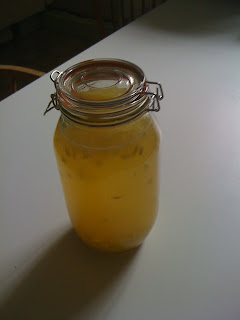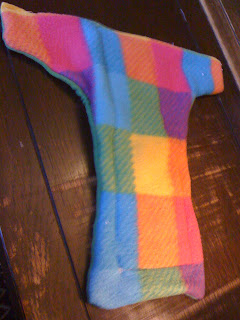As I explained before, I started using prefolds (Bambino Mio) when my son was about a month old. We did nnot get along with them very well. Then I switched to Motherease one size which were great. But for my daughter I would like to have something to use in the beginning because the one size are so bulky!
I have been searching out small sized nappies, using all in ones, like Bumgenius, or Charlie Banana...but they all seem like such expensive options when I have such a great set of nappies already. And since I have been on Statutory Sick Pay for a few months my budget just dwindled to near nothing.
So I figured making a few nappies would be the best option overall. I do intend to buy small ready made covers from Babykind. I could make them cheaper by buying PUL and binding, etc, but the fit has to be just right and I don't think it will be cheaper if I make loads of mistakes.
The inner, shaped nappies, however are EASY! I used a cheap fleece blanket from IKEA. some old t-shirts, some of my old terries from my son, a few old towels and flannels. This made my set free, because these were all in my house. I even used the elastic from an old, ripped, fitted bedsheet. Though if you are going to purchase anything, elastic is probably a good choice.
There are plenty of suppliers who can provide a number of suitable waterproof, natural, fleecy, colourful etc fabrics which are suitable for making nappies. And many are suitable for making your own all-in-ones, which could save you money. I feel that my sewing skills do not reach this far and that buying nappies is actually a money/time saver. But needs must, so here are my homemade nappies.
I will include links to other websites with great directions. Mine are a bit haphazard as I was experimenting quite a bit. I am very happy with mine and I really hope that they will be suitable when baby arrives.
1. I needed them to be much smaller than my motherease one size, so I took a newborn disposable nappy (an eco-friendly free sample), and traced it out on some fleece.
2. I kept experimenting with this until I tapered it enough, had long enough tabs to fasten around the front, etc. This was tricky without an actual baby. Plus I don't know what size she will be when she comes out! So I actually have a few slight variations on this design.
3. I cut out my patterns in fleece and t-shirt or flannel. I decided to use fleece on one side and cotton on the other. Fleece wicks away moisture from baby's skin, so results in a drier nappy for baby. But some babies find synthetic fibres irritating to the skin or just too hot in summer, so my nappies are effectively reversible. I will use nappy pins and nappy nippas (which I don't get on with really) to begin with. If I find a side she likes more I might attach velcro or snaps later. If you are confident in your choice of materials then go ahead and attach velcro or snaps at the end of these directions.
4. I cut out two to three rectangles of terry/towel/flannel depending on thickness. I sewed this down to the centre of the fleece.
5. Then I sewed about 5 inches of elastic (stretching it out as I sewed) on either side of the terry right in the middle where the nappy will wrap around the legs.
6. Next I sewed the cotton layer to the wrong side of the fleece, almost all of the way around. Then flipped it through to the right sides and sewed the gap.
7. Wash your nappies
without fabric softener three times before use. Fleece is particular become less absorbent when the soap isn't rinsed out enough. So an extra rinse cycle is helpful if you find they leak a bit. I will be trying out my new soap nuts with these nappies and see how they perform. (I used Fairy and a hot wash with my motherease)
Look for my other posts on cloth nappies for more information on using them.
sewingclothnappies
How to Make Cloth Diapers--basically the pattern I used above (adapted)
diaperswappers.com
clothdiapernation.com
clothnappyforum---UK based forum
adventuresindiapering
diaperjungle
diapersewing.com--lots of patterns including for making covers and converting prefolds to fitted
If you are looking for materials and can't find what you like above, I would search using the terms "buy PUL fabric in UK" or "buy diaper materials in USA" or similar. I did get several websites, but chose not to go down that route so cannot endorse any particular company. My mother purchased some PUL from her fabric store to make me some wet bags to store wet nappies in while I am out and about. I will post on this when she gets here in the summer.























